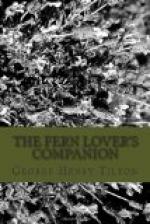[Footnote 1: In the accompanying illustration, it should be remembered that the reproductive parts of a fern are microscopic and cannot be seen by the naked eye.]
Fern plants have been known to spring directly from the prothallus by a budding process apart from the organs of fertilization, showing that Nature “fulfills herself in many ways."[2]
[Footnote 2: The scientific term for this method of reproduction is apogamy (apart from marriage). Sometimes the prothallus itself buds directly from the frond without spores, for which process the term apospory is used. (Meaning, literally, without spores.)]
VERNATION
All true ferns come out of the ground head foremost, coiled up like a watch-spring, and are designated as “fiddle-heads,” or crosiers. (A real crosier is a bishop’s staff.) Some of these odd young growths are covered with “fern wool,” which birds often use in lining their nests. This wool usually disappears later as the crosier unfolds into the broad green blade. The development of plant shoots from the bud is called vernation (Latin, ver meaning spring), and this unique uncoiling of ferns, “circinnate vernation.”
VEINS
The veins of a fern are free, when, branching from the mid-vein, they do not connect with each other, and simple when they do not fork. When the veins intersect they are said to anastomose (Greek, an opening, or network), and their meshes are called areolae or areoles (Latin, areola, a little open space).
EXPLANATION OF TERMS
A frond is said to be pinnate (Latin, pinna, a feather), when its primary divisions extend to the rachis, as in the Christmas fern (Fig. 1). A frond is bipinnate (Latin, bis, twice) when the lobes of the pinnae extend to the midvein as in the royal fern (Fig. 2). These divisions of the pinnae are called pinnules. When a frond is tripinnate the last complete divisions are called ultimate pinnules or segments. A frond is pinnatifid when its lobes extend halfway or more to the rachis or midvein as in the middle lobes of the pinnatifid spleenwort (Fig. 3). The pinnae of a frond are often pinnatifid when the frond itself is pinnate; and a frond may be pinnate in its lower part and become pinnatifid higher up as in the pinnatifid spleenwort just mentioned (Fig. 3).




